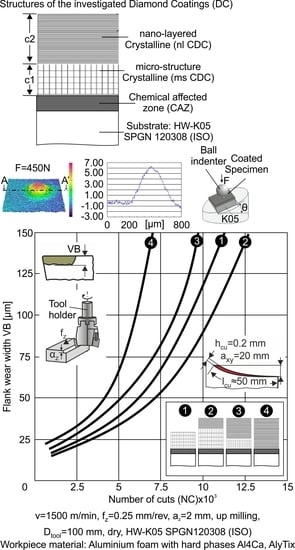Optimization of Crystalline Diamond Coating Structure Architecture for Improving Adhesion and Cutting Performance in Milling with Cemented Carbide Inserts
Abstract
1. Introduction
2. Materials and Methods
3. Results
3.1. Impact Performance of the Examined Diamond Coatings
3.2. Milling Performance of the Examined Diamond Coatings
4. Discussion
5. Conclusions
Author Contributions
Funding
Institutional Review Board Statement
Informed Consent Statement
Data Availability Statement
Conflicts of Interest
References
- Haubner, R.; Kalss, W. Diamond Deposition on Hardmetal Substrates—Comparison of Substrate pretreatments and Industrial Applications. Int. J. Refract. Met. Hard Mater. 2010, 28, 475–483. [Google Scholar] [CrossRef]
- Uhlmann, E.; Reimers, W.; Byrne, F.; Klaus, M. Analysis of tool wear and residual stress of CVD diamond coated cemented carbide tools in the machining of aluminum silicon alloys. Prod. Eng. 2010, 4, 203–209. [Google Scholar] [CrossRef]
- Skordaris, G.; Kotsanis, T.; Boumpakis, A.; Stergioudi, F. Improvement of the Interfacial Fatigue Strength and Milling Behavior of Diamond Coated Tools via Appropriate Annealing. Coatings 2020, 10, 821. [Google Scholar] [CrossRef]
- Wang, H.; Yang, J.; Sun, F. Cutting performances of MCD, SMCD, NCD and MCD/NCD coated tools in high-speed milling of hot bending graphite molds. J. Mater. Process. Technol. 2020, 276, 116401. [Google Scholar] [CrossRef]
- Sousa, V.F.C.; Silva, F.J.G. Recent Advances on Coated Milling Tool Technology—A Comprehensive Review. Coatings 2020, 10, 235. [Google Scholar] [CrossRef]
- Lee, D.-G.; Fitz-Gerald, J.M.; Singh, R.K. Novel Method for Adherent Diamond Coatings on Cemented Carbide Substrates. Surf. Coat. Technol. 1998, 100–101, 187–191. [Google Scholar] [CrossRef]
- Skordaris, G.; Bouzakis, K.-D.; Charalampous, P.; Kotsanis, T.; Bouzakis, E.; Lemmer, O. Effect of structure and residual stresses of diamond coated cemented carbide tools on the film adhesion and developed wear mechanisms in milling. CIRP Ann. Manuf. Technol. 2016, 65, 101–104. [Google Scholar] [CrossRef]
- Bouzakis, K.-D.; Skordaris, G.; Bouzakis, E.; Charalampous, P.; Kotsanis, T.; Tasoulas, D.; Kombogiannis, S.; Lemmer, O. Effect of the interface fatigue strength of NCD coated hard metal inserts on their cutting performance in milling. Diam. Relat. Mater. 2015, 59, 80–89. [Google Scholar] [CrossRef]
- Wu, T.; Cheng, K. Micro milling performance assessment of diamond-like carbon coatings on a micro-end mill. Proc. Inst. Mech. Eng. Part J J. Eng. Tribol. 2013, 227, 1038–1046. [Google Scholar] [CrossRef]
- Bouzakis, K.-D.; Skordaris, G.; Bouzakis, E.; Makrimallakis, S.; Kombogiannis, S.; Lemmer, O. Fatigue strength of diamond coatings’ interface assessed by inclined impact test. Surf. Coat. Technol. 2013, 237, 135–141. [Google Scholar] [CrossRef]
- Fan, S.; Kuang, T.; Xu, W.; Zhang, Y.; Su, Y.; Lin, S.; Wang, D.; Yang, H.; Zhou, K.; Dai, M.; et al. Effect of pretreatment strategy on the microstructure, mechanical properties and cutting performance of diamond coated hardmetal tools using HFCVD method. Int. J. Refract. Met. Hard Mater. 2021, 101, 105687. [Google Scholar] [CrossRef]
- Rugóczky, P.; Muránszky, G.; Lakatos, J. Comparative investigations of the selective Co etching from hardmetal support layer of diamond coating. IOP Conf. Ser. Mater. Sci. Eng. 2019, 613, 012015. [Google Scholar] [CrossRef]
- Polini, R.; Kumashiro, S.; Jackson, M.J.; Amar, M.; Ahmed, W.; Sein, H. A study of diamond synthesis by hot filament chemical vapor deposition on Nc coatings. J. Mater. Eng. Perform. 2005, 15, 218–222. [Google Scholar] [CrossRef]
- Silva, S.; Mammana, V.P.; Salvadori, M.C.; Monteiro, O.R.; Brown, I.G. WC–Co cutting tool inserts with diamond coatings. Diam. Relat. Mater. 1999, 8, 1913–1918. [Google Scholar] [CrossRef]
- Wang, C.; Wang, X.; Sun, F. Tribological behavior and cutting performance of monolayer, bilayer and multilayer diamond coated milling tools in machining of zirconia ceramics. Surf. Coat. Technol. 2018, 353, 49–57. [Google Scholar] [CrossRef]
- Woehrl, N.; Hirte, T.; Posth, O.; Buck, V. Investigation of the Coefficient of Thermal Expansion in Nanocrystalline Diamond Films. Diam. Relat. Mater. 2009, 18, 224–228. [Google Scholar] [CrossRef]
- Slack Glen, A.; Bartram, S.F. Thermal Expansion of Some Diamond-like Crystals. J. Appl. Phys. 1975, 46, 89–98. [Google Scholar] [CrossRef]
- Impact-BZ Ltd. Available online: www.impact-bz.com (accessed on 11 January 2023).
- Cheng, K. (Ed.) Machining Dynamics: Theory, Applications and Practices; Springer: London, UK, 2008. [Google Scholar]
- Teppernegg, T.; Klünsner, T.; Kremsner, C.; Tritremmel, C.; Czettl, C.; Puchegger, S.; Marsoner, S.; Pippan, R.; Ebner, R. High temperature mechanical properties of WC–Co hard metals. Int. J. Refract. Met. Hard Mater. 2016, 56, 139–144. [Google Scholar] [CrossRef]
- Bouzakis, K.D.; Makrimallakis, S.; Skordaris, G.; Bouzakis, E.; Kombogiannis, S.; Katirtzoglou, G.; Maliaris, G. Coated tools’ performance in up and down milling stainless steel, explained by film mechanical and fatigue properties. Wear 2013, 303, 546–559. [Google Scholar] [CrossRef]
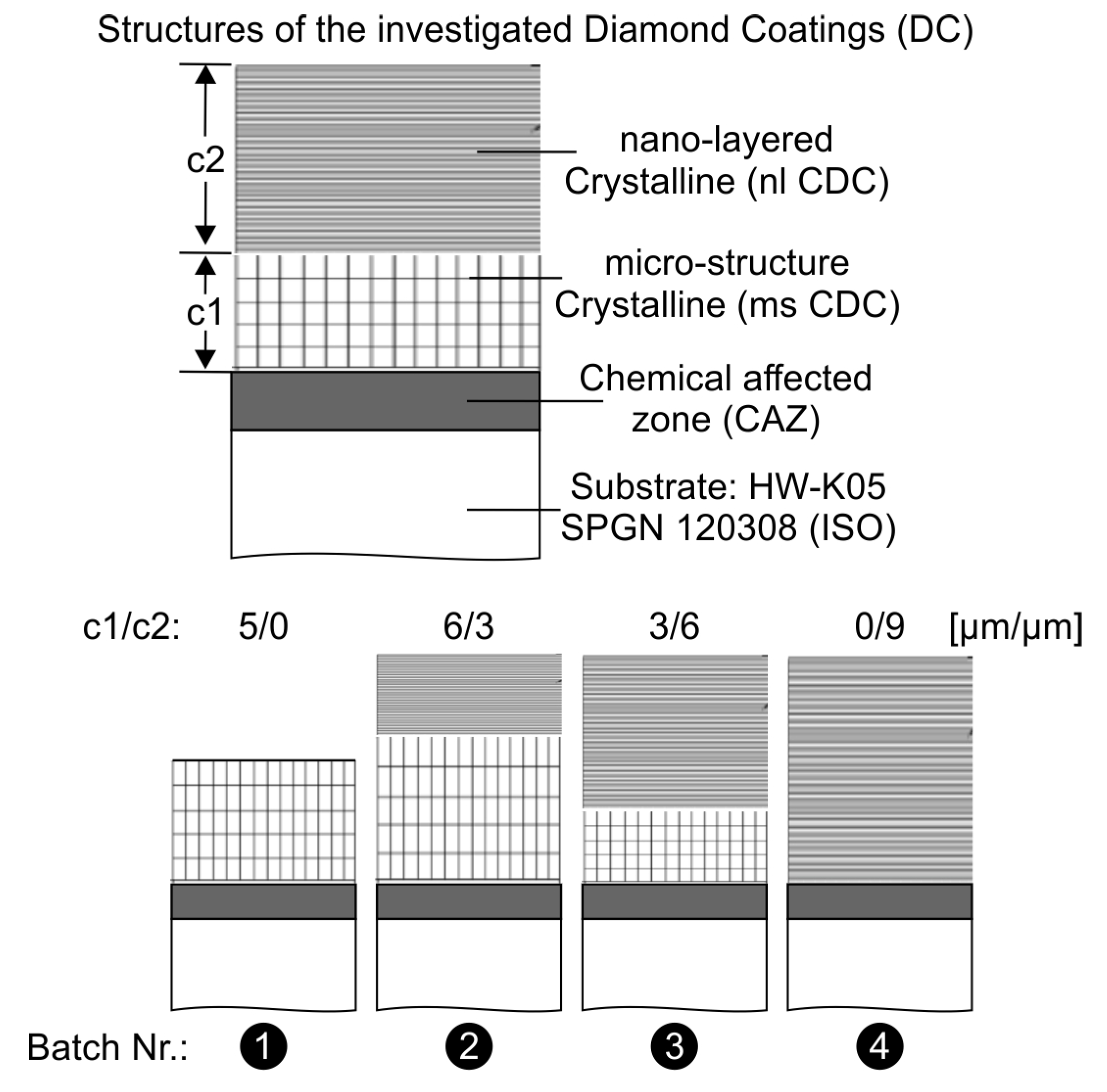
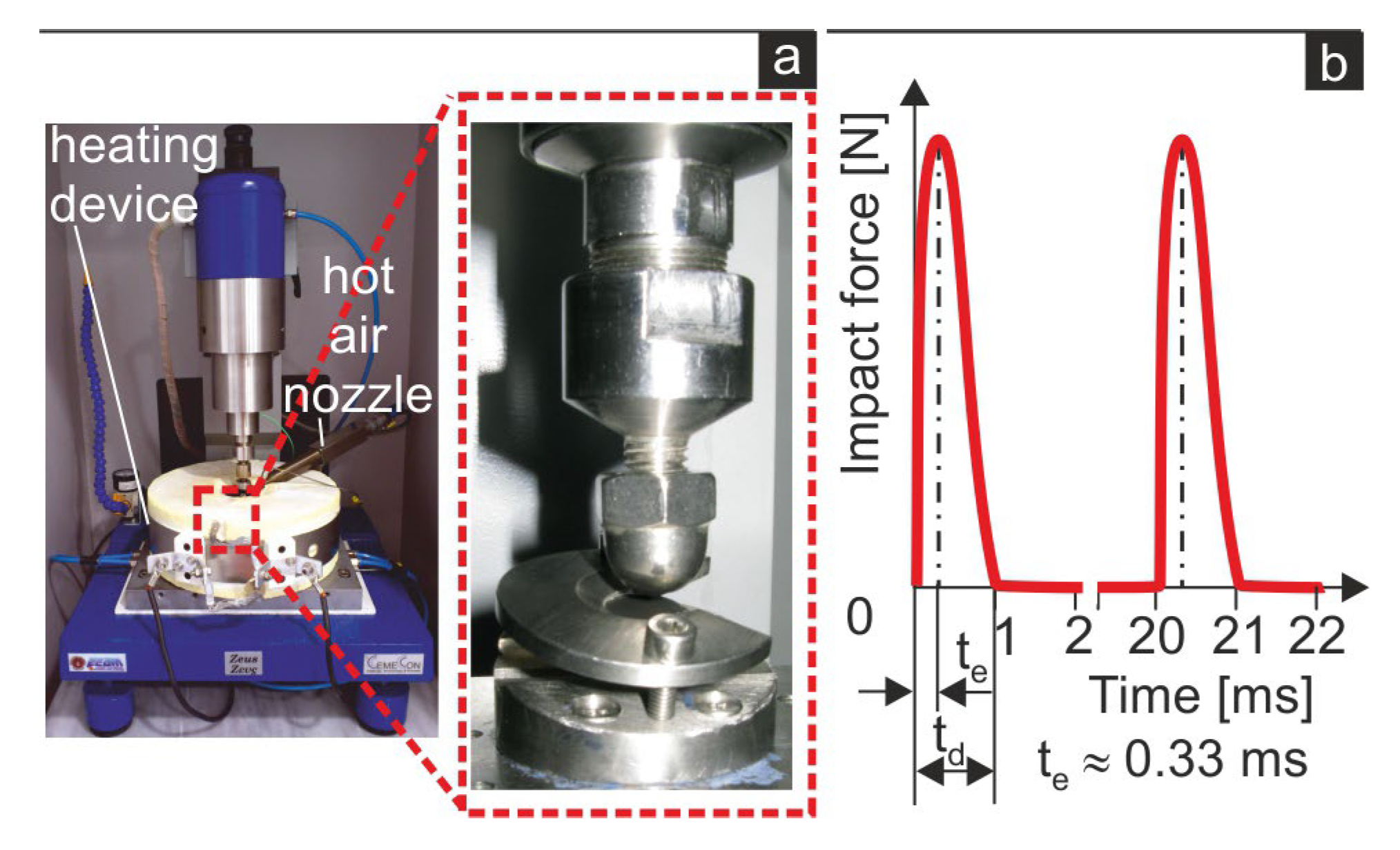


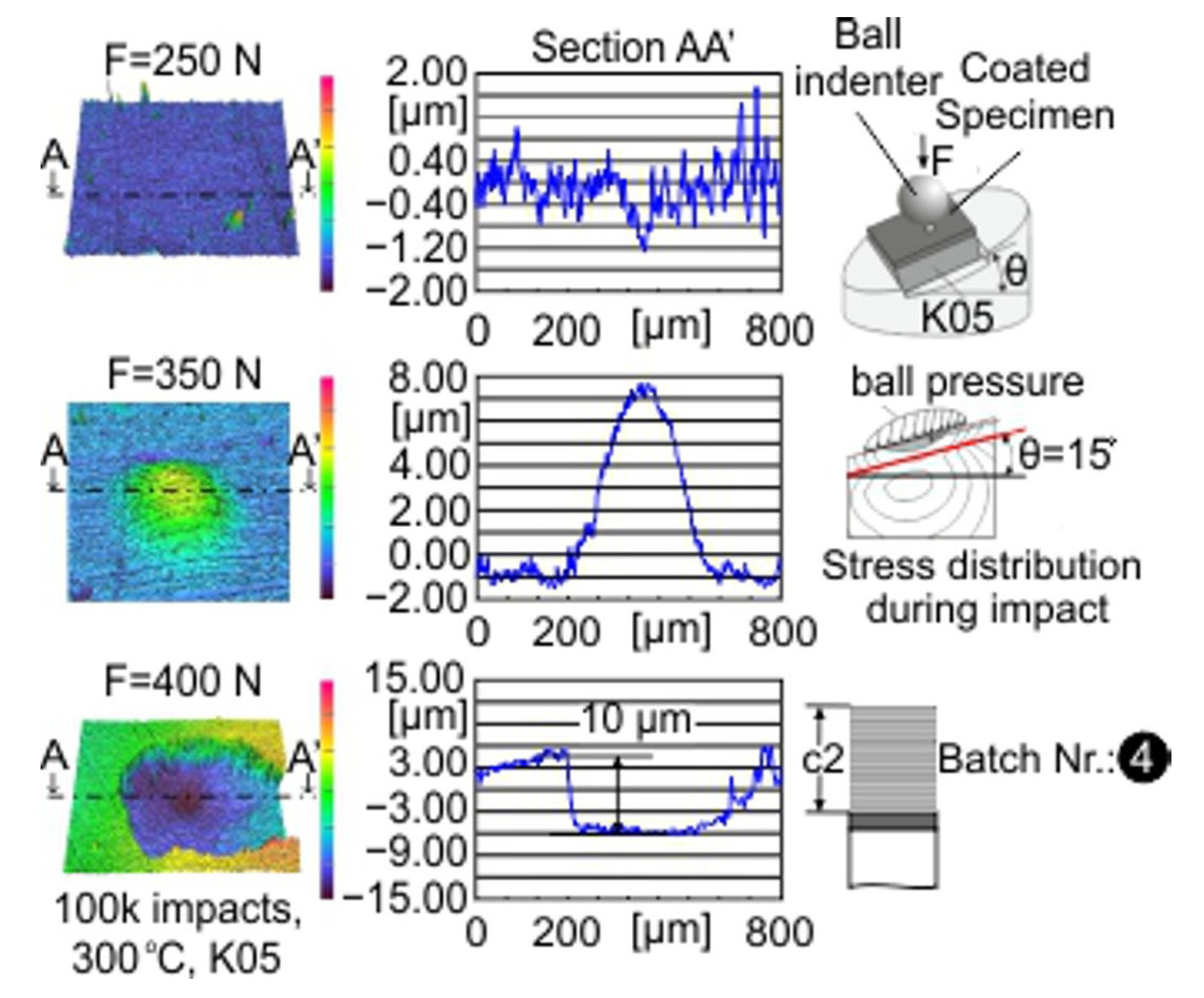
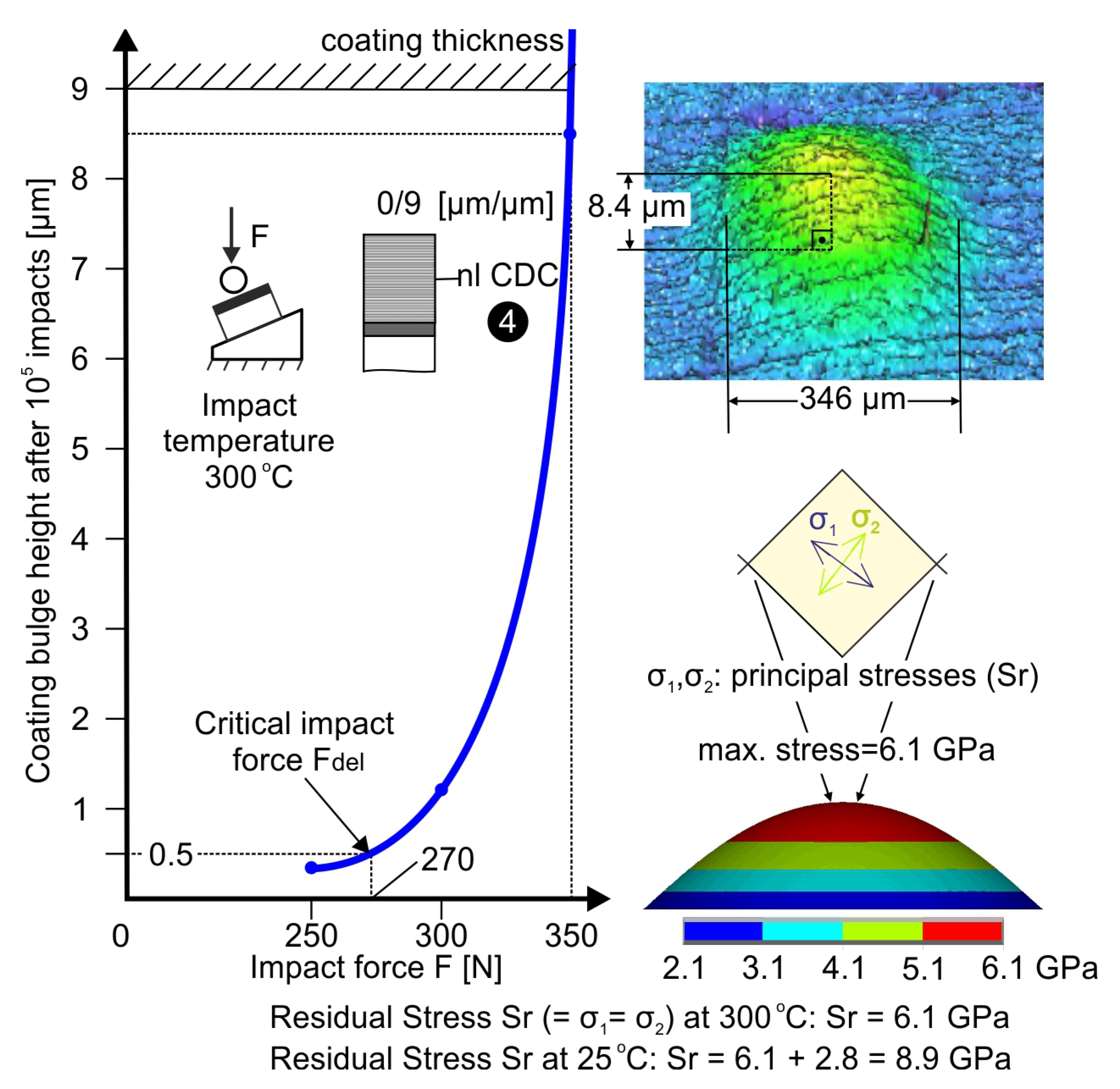


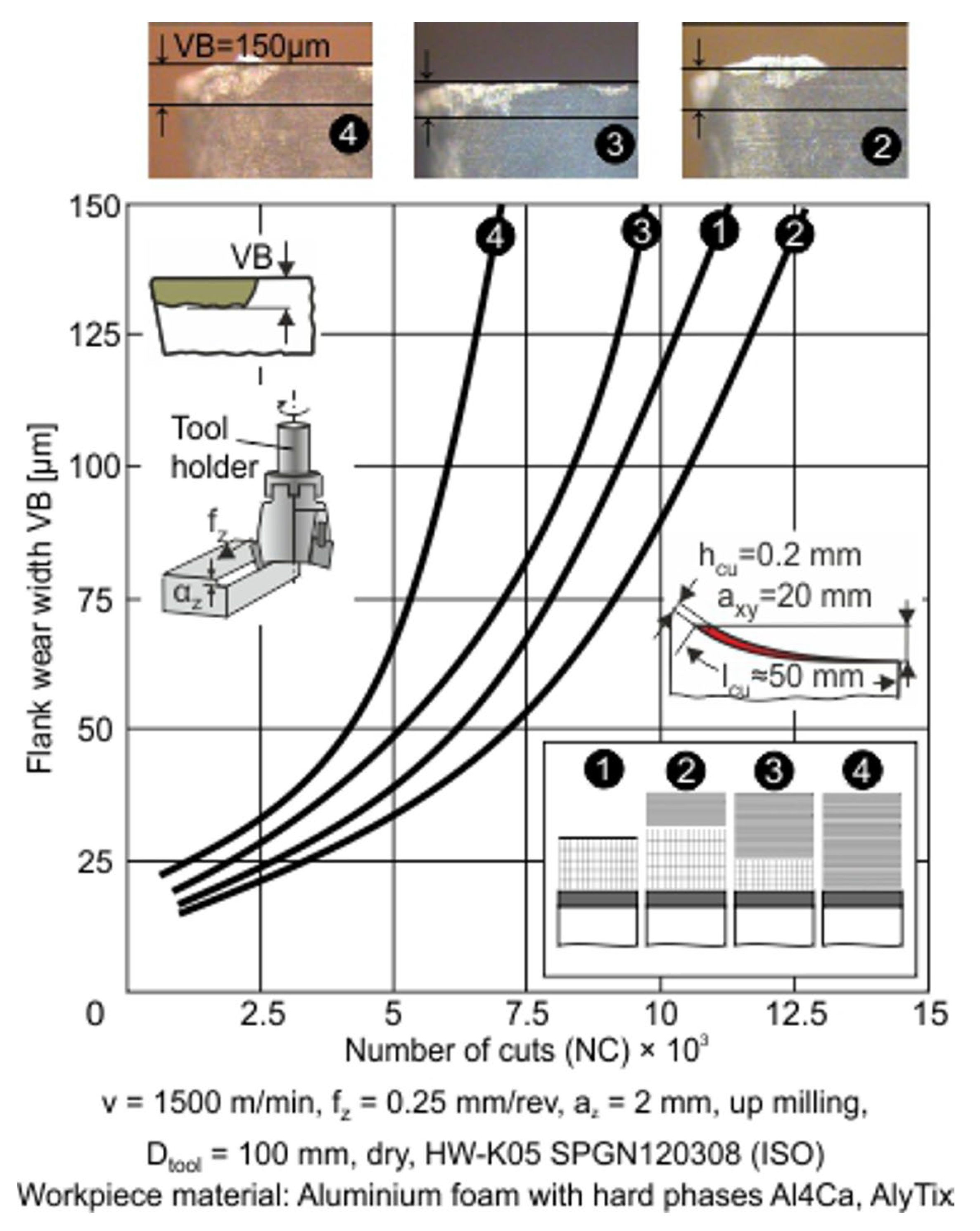
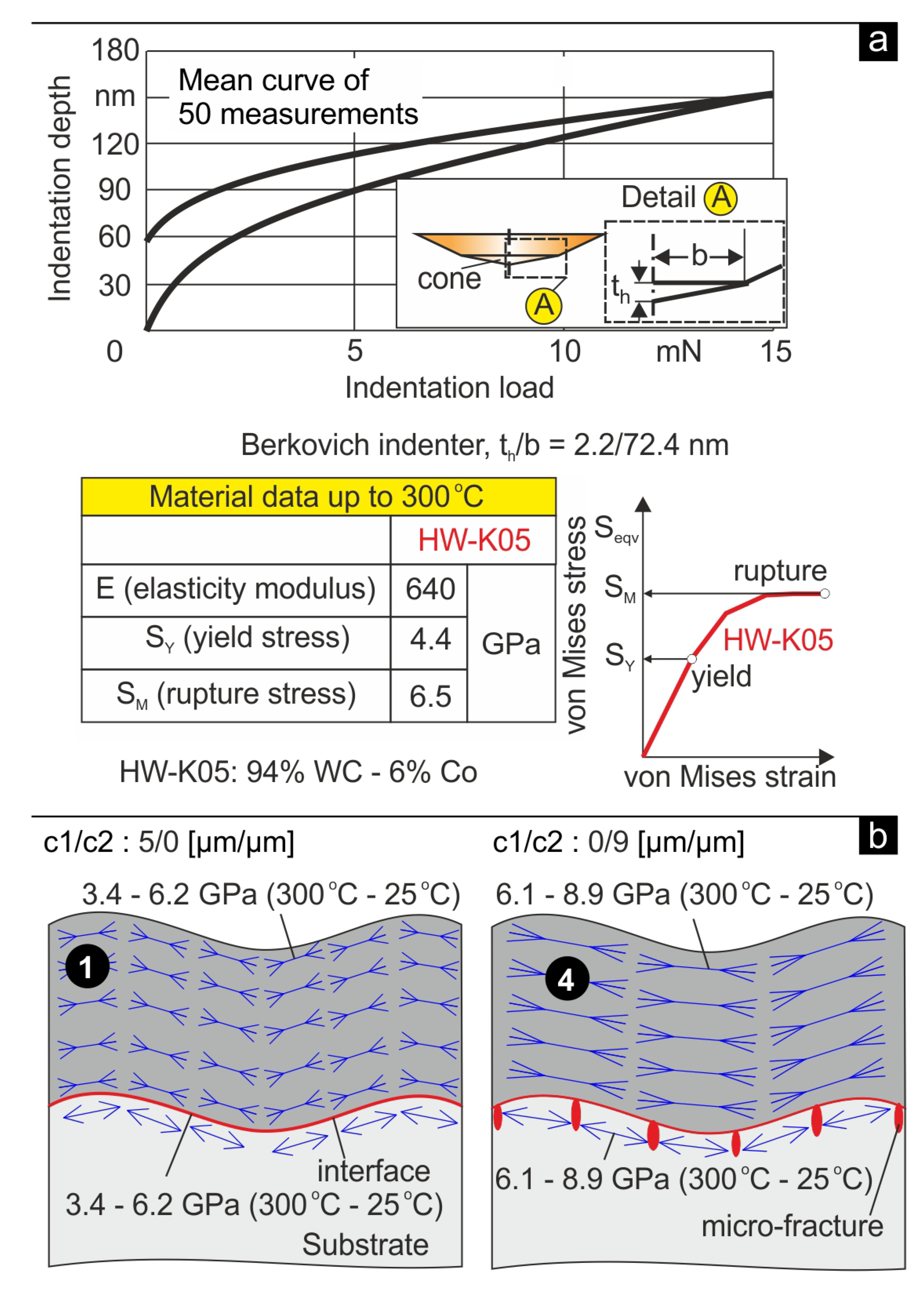
Disclaimer/Publisher’s Note: The statements, opinions and data contained in all publications are solely those of the individual author(s) and contributor(s) and not of MDPI and/or the editor(s). MDPI and/or the editor(s) disclaim responsibility for any injury to people or property resulting from any ideas, methods, instructions or products referred to in the content. |
© 2023 by the authors. Licensee MDPI, Basel, Switzerland. This article is an open access article distributed under the terms and conditions of the Creative Commons Attribution (CC BY) license (https://creativecommons.org/licenses/by/4.0/).
Share and Cite
Skordaris, G.; Bouzakis, K.-D.; Bouzakis, A.; Tsakalidis, D.; Boumpakis, A.; Kompogiannis, S.; Bouzakis, E.; Lemmer, O.; Kölker, W.; Woda, M. Optimization of Crystalline Diamond Coating Structure Architecture for Improving Adhesion and Cutting Performance in Milling with Cemented Carbide Inserts. Coatings 2023, 13, 1170. https://doi.org/10.3390/coatings13071170
Skordaris G, Bouzakis K-D, Bouzakis A, Tsakalidis D, Boumpakis A, Kompogiannis S, Bouzakis E, Lemmer O, Kölker W, Woda M. Optimization of Crystalline Diamond Coating Structure Architecture for Improving Adhesion and Cutting Performance in Milling with Cemented Carbide Inserts. Coatings. 2023; 13(7):1170. https://doi.org/10.3390/coatings13071170
Chicago/Turabian StyleSkordaris, Georgios, Konstantinos-Dionysios Bouzakis, Antonios Bouzakis, Dimitrios Tsakalidis, Apostolos Boumpakis, Spyridon Kompogiannis, Emmanouil Bouzakis, Oliver Lemmer, Werner Kölker, and Michael Woda. 2023. "Optimization of Crystalline Diamond Coating Structure Architecture for Improving Adhesion and Cutting Performance in Milling with Cemented Carbide Inserts" Coatings 13, no. 7: 1170. https://doi.org/10.3390/coatings13071170
APA StyleSkordaris, G., Bouzakis, K.-D., Bouzakis, A., Tsakalidis, D., Boumpakis, A., Kompogiannis, S., Bouzakis, E., Lemmer, O., Kölker, W., & Woda, M. (2023). Optimization of Crystalline Diamond Coating Structure Architecture for Improving Adhesion and Cutting Performance in Milling with Cemented Carbide Inserts. Coatings, 13(7), 1170. https://doi.org/10.3390/coatings13071170






